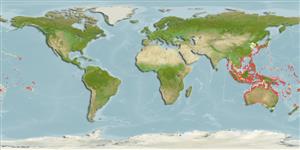>
Elopiformes (Tarpons and tenpounders) >
Elopidae (Tenpounders)
Etymology: Elops: Greek, ellops = a kind of serpent (Ref. 45335).
More on author: Regan.
Environment: milieu / climate zone / depth range / distribution range
ນິເວດວິທະຍາ
ສັດທະເລ; ນ້ຳຈືດ; ນ້ຳກ່ອຍ; ປາທີ່ມີການເຄື່ອນຍ້າຍຈາກທະເລ ແລະ ໄປໄຂ່ຢູ່ນ້ຳຈືດ (Ref. 51243); ລະດັບຄວາມເລິກ 1 - 30 m (Ref. 6898). Tropical; 41°N - 40°S, 92°E - 138°W
Indo-Pacific: from the Andaman Sea in the Eastern Indian Ocean to Western Australia and in the Pacific, from southern Japan to New South Wales and New Caledonia; throughout most of Oceania to the Hawaiian Is., Society Is., and Tuamotus (Ref. 86689). Currently treated as a single species, but this status should be considered provisional. Further studies may reveal a complex of closely related species, as in the case of Albula.
ຂະໜາດ / ນ້ຳໜັກ / Age
Maturity: Lm ? range ? - ? cm
Max length : 120 cm SL ຕົວຜູ້/ບໍ່ມີເພດ; (Ref. 44894); common length : 50.0 cm SL ຕົວຜູ້/ບໍ່ມີເພດ; (Ref. 10983); ນ້ຳໜັກສູງສຸດທີ່ເຄຍຈັດພີມມາ: 10.1 kg (Ref. 6736)
ຄີ (ໜາມ)ແຂງຢູ່ຫຼັງປາ (ທັງໝົດ): 0; ຄີຫຼັງຂອງປາ (ຄີອ່ອນ) (ທັງໝົດ): 23-27; ຄີ(ໜາມ) ແຂງຢູ່ຄີກົ້ນປາ
ກຸ່ມປາກະດູກແຂງ
ຄວາມຖີ່ຂອງກຸ່ມຖ່າຍທອດພັນ
ປາທີ່ມີການເຄື່ອນຍ້າຍຈາກທະເລໄປຫານ້ຳຈືດ ແລະນ້ຳຈືດຫາທະເລ
ປາທີ່ມີການເຄື່ອນຍ້າຍຈາກທະເລແລະໄປໄຂ່ຢູ່ນ້ຳຈືດ
ຄີກົ້ນຂອງປາ
ສັດທີ່ມີກະດູກສັນຫັຼງ
ການຖ່າຍທອດທາງກຳມະພັນຈາກພໍ່ແມ່ຫາລູກ 0; ຄີກົ້ນຂອງປາ: 14 - 18. A gular plate present between arms of lower jaw. Branchiostegal rays numerous, approximately 20-25. All fins without spines. Scales very small, approximately 100 in lateral line.
A coastal fish, commonly entering lagoon, bays, and estuaries (including fishponds) (Ref. 2847, 58302), particularly around mangroves (Ref. 44894). Sometimes enters freshwater streams, but does not penetrate very far inland (Ref. 2847). Benthopelagic (Ref. 58302). Younger fish often penetrate the lower freshwater reaches of rivers (Ref. 44894). An active swimmer, commonly traveling in schools in open water. Feeds on various fishes and crustaceans. Little detailed knowledge exists of its biology. Has a leptocephalus larva. Spawning takes place offshore and young larvae are found in the open sea, moving close to shore as they develop. Juveniles commonly found in salt marshes, canals, and tidal streams. Marketed fresh or frozen; in some places ground up as fish meal. A good sport fish on light tackle, striking a variety of artificial lures as well as live shrimp or baitfish. No separate statistics available. (Ref. 10983).
Life cycle and mating behavior
ການຈະເລີນເຕັມໄວ | ການສືບພັນ | ການວາງໄຂ່ | ໄຂ່ | ຄວາມດົກຂອງໄຂ່ປາ | ຕົວອ່ອນ
Smith, D.G., 1997. Elopidae. Ladyfishes, tenpounders. p. 1619-1620. In K.E. Carpenter and V.H. Niem (eds.) FAO species identification guide for fishery purposes. The living marine resources of the WCP. Vol. 3. Batoid fishes, chimaeras and bony fishes part 1 (Elopidae to Linophrynidae). FAO, Rome. (Ref. 10983)
IUCN Red List Status (Ref. 130435)
Human uses
ການປະມົງ: ເປັນສີນຄ້າ; ຊະນິດປາທີ່ຖືກນຳໃຊ້ເຂົ້າໃນການຫາເພື່ອເປັນເກມກິລາ: ແມ່ນ
ຂໍ້ມູນຕື່ມອີກ
ຊື່ສາມັນຄຳສັບຄ້າຍຄືກັນການເຜົາໃໝ້ພະລັງງານໂດຍປ່ຽນທາດອາຫານໃນຮ່າງກາຍໃຫ້ກາຍເປັນຊີ້ນແລະໜັງຜູ້ລ້າການສຶກສາຜົນກະທົບຂອງສານຜິດທີ່ມີຜົນກະທົບຕໍ່ລະບົບນິເວດການສືບພັນການຈະເລີນເຕັມໄວການວາງໄຂ່ການສັງລວມການວາງໄຂ່ຄວາມດົກຂອງໄຂ່ປາໄຂ່Egg development
ເອກະສານອ້າງອີງການລ້ຽງສັດນ້ຳຂໍ້ມູນການລ້ຽງສັດນ້ຳສາຍພັນກຳມະພັນElectrophoresesການຖ່າຍທອດທາງກຳມະພັນຈາກພໍ່ແມ່ຫາລູກພະຍາດການປຸງແຕ່ງNutrientsMass conversion
ຜູ້ຮ່ວມມືຮູບStamps, Coins Misc.ສຽງຫອຍມີພິດຊະນິດນຶ່ງທີ່ອາໄສໃນທະເລຄວາມໄວປະເພດການລອຍເນື້ອທີ່ເຫືອກOtolithsສະໝອງວິໄສທັດ
ເຄື່ອງມື
Special reports
Download XML
ແຫຼ່ງອີນເຕີເນັດ
Estimates based on models
Preferred temperature (Ref.
123201): 24.5 - 29.3, mean 28.6 °C (based on 2710 cells).
Phylogenetic diversity index (Ref.
82804): PD
50 = 0.5176 [Uniqueness, from 0.5 = low to 2.0 = high].
Bayesian length-weight: a=0.00589 (0.00256 - 0.01357), b=2.99 (2.79 - 3.19), in cm total length, based on LWR estimates for this (Sub)family-body shape (Ref.
93245).
ຊັ້ນເຂດຮ້ອນ (Ref.
69278): 4.0 ±0.62 se; based on food items.
ຄວາມຢືດຢຸ່ນ (Ref.
120179): ຕຳ່, ປະຊາກອນຕຳ່ສຸດທີ່ໃຊ້ເວລາສອງເທົ່າ 4.5 - 14 ປີ (Preliminary K or Fecundity.).
Fishing Vulnerability (Ref.
59153): Very high vulnerability (88 of 100).
Nutrients (Ref.
124155): Calcium = 77.5 [47.6, 137.7] mg/100g; Iron = 1.11 [0.70, 1.81] mg/100g; Protein = 16.8 [14.3, 19.8] %; Omega3 = 0.162 [0.090, 0.301] g/100g; Selenium = 50.9 [26.7, 100.8] μg/100g; VitaminA = 18.3 [7.4, 44.7] μg/100g; Zinc = 0.994 [0.727, 1.368] mg/100g (wet weight);
